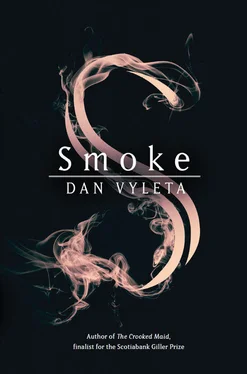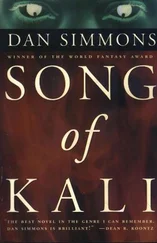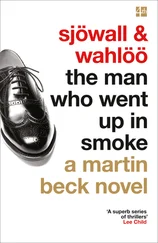Separated from the girl by some thirty pages rests the picture of a familiar pairing. Master Renfrew and Baron Naylor stand shoulder to shoulder on an open plain of such pancake flatness that the horizon forms a straight, smooth line. As in the picture in the gym, they are both much younger: Renfrew a university student, the baron a man of forty in a thick worsted suit. The light is so bright that the sky above the two figures appears the purest white. It is as though they are standing with their heads dunked into the void. Beneath their heavy boots, the ground is made of coarse, wild grass. There is no landscape in the whole of England as big, as flat as this. It is so barren, they might be standing on the moon.
But it is another detail that has caught Thomas’s eye. Haltingly, his fingers clumsy and swollen, each movement painful to him, he reaches over and takes the picture out of Charlie’s hand; holds it up to the lamp at a flat angle, then rubs one corner between his fingers as though testing a piece of cloth.
“Feel it, Charlie. This is not a daguerreotype. And look — when you hold the lamp close, it glows like it’s shot through with silver.”
Charlie understands him at once. “Some new technology; from the Continent. Despite the embargo.”
“New for us. But this print must be fifteen years old.” Thomas replaces the picture between the pages of the journal. “This alone is enough to land Lady Naylor in jail.”
ф
They continue looking. After a few minutes Thomas, trusting to moonlight, shifts away from the desk of papers, and limps onwards, into the next room. Charlie, meanwhile, has become immersed in what appears to be a ledger, lying open to its latest entry. He is unfamiliar with the high art of bookkeeping, but expenses and income are recorded in different-coloured ink — red and black — and as such are immediately identifiable. The sums listed for expenses are enormous. One particular item draws the eye. The figure indicated is so large, that initially Charlie thinks he must have misread it. The item is identified only as a “delivery”; a date has been added in pencil: “12 January.” Less than two weeks from now. The baroness has paid for her order in advance. A letter is attached to the page by a pin, taciturn to the point of obscurity. It, too, makes reference to a delivery and identifies the same date. “Tobacco Dock. The Haarlem (La Rochelle). Midnight. Pls collect in person & arrange for transport.” A Captain van Huysmans is undersigned.
As for the ledger’s income column, each figure in it is replicated in a separate column marked with a capital D. Charlie cannot make sense of this odd doubling until he chances on the notion that D must stand for “debt.” A name follows each sum in this column, always the same, always written out in full with such a show of fastidiousness that it takes on the flavour of obsession.
Spencer.
Spencer.
Spencer.
Spencer.
Spencer.
It is as though Lady Naylor does not want to allow herself to forget to whom she owes her money. The figure that is carried over from previous pages is already so large that the implication is clear. The Naylors must be bankrupt. For all intents and purposes the Spencers own them. Which is to say Julius owns them, the moment his grandfather dies. The man is said to be very old, and bedridden with gout.
ф
Charlie moves away from the ledger, continues drifting through the room. There are other mysteries. There is a desk, for instance, almost entirely covered with technical drawings. Many of them are rendered on dark blue paper of a peculiar texture. The drawings themselves are white. As Charlie tries to spread them out, a few tumble to the ground. He sees Livia wince at the noise; retrieves them, and immediately realises that he cannot reproduce their former order. The topmost shows a warren of long, intersecting alleyways: a system so complex and angular that it is difficult to picture a city built according to its principles. But perhaps the chart is showing a railway system, or an archaeological site. The only clue as to what Charlie is looking at is provided by a single word, printed in ornamental capitals along the drawing’s lower edge. A·S·C·H·E·N·S·T·E·D·T . Charlie has never heard of a place by that name. But he knows that Asche is German for ash, and Stedt very nearly the German word for city. A City of Ashes. The phrase conjures images of a thousand furnaces burning in the dark.
A hiss from Thomas snaps Charlie out of his musings and beckons him to follow. The second room appears to be the laboratory proper. The walls here are lined with pharmaceutical equipment: jars and glass tubes, rows of chemicals in dark brown bottles. Several apparatuses are set out on tables, though none are currently in use. A microscope takes pride of place on a separate desk. Thomas stands stooped near it, his hands leafing through a pile of notebooks.
“All her notes are in French. And over there, there’s a library of scientific texts. Books in German, Italian, Russian — you name it. Most of them illegal, no doubt. And then there is this.”
Thomas pulls Charlie over to a glass case in one corner. Here, too, apothecary bottles are lined up. Each of them is carefully labelled with a person’s name and a date. Each of them contains a black substance, more liquid than powder.
Soot.
Thomas opens the door of the glass case and points to a few of the bottles.
“James Hardy, remember him? No? A legal clerk. Accused of murdering his wife and children. The newspapers went wild about him. Two or three years ago, in Hexham, it was, up north. He was hanged.” He points to the label. “On my birthday — that’s why I remember it. And here, Anne MacNamara. You know about her, surely?”
Charlie does. “She burnt down a church in Ipswich. More than fifty dead. She said she got the idea from a book. I remember my parents talking about her trial.”
“Sentenced to death. I don’t remember the date, but I bet you it is what it says on the bottle. Early last summer.”
Charlie scans the many bottles. There are more than two dozen.
“You think all of them—”
“Yes.”
“And all of them criminals. Murderers.”
“Yes. She harvests their Soot when they are executed.”
Charlie winces at the word. Harvest . It’s what the devil is said to do with souls.
“What else have you found, Thomas?”
“Slides for the microscope. Soot, blood drops, bits of tissue. Grains from those cigarettes: she has sliced them open and studied the contents. Medical texts, anatomy charts. The only thing in English I saw is a handwritten treatise on some kind of surgical procedure. But it’s hard to read by moonlight. Then there’s this.”
Thomas takes the lamp out of Charlie’s hands, trains it on another shelf. Its beam finds a row of glass jars in which strange, mottled objects hang, as though weightless, suspended in a liquid too viscous to be water. It takes Charlie a moment to identify them as bodily organs. Lungs and livers feature prominently, familiar enough from the school dinner table, where offal remains a staple. Their spongy tissue looks pale and bloated in the preserving fluid.
“From humans?”
Thomas shrugs. There is no need to say it. What interest could Lady Naylor have in animal parts?
Livia’s voice carries to them from the front room. “We must go.”
“One more minute.” Thomas turns his back on the jars and pulls Charlie along, to the last of the rooms. “Just a quick glance.”
The beam of the light travels before them. They themselves never make it past the threshold of the door.
In size it is a room much like the others: square, wood-panelled, a narrow window closed upon the night. There are more desks here and more shelves; books, scientific tools, a dusty sheet that hides some bulky machine.
Читать дальше












